CAT Exam > CAT Questions > Directions: Study the following information c...
Start Learning for Free
Directions: Study the following information carefully and answer the question.
In a bustling city known for its thriving tech industry, three talented sales professionals, Alex, Emma, and Liam, were entrusted with the task of promoting an innovative software solution called LinkPro to various businesses. Each week, they were assigned different territories to cover. Once a sales professional enters in a particular territory, he can meet any number of businessmen and any businessman can buy any number of software or may not buy any software. The success rate of a sales professional for a week is defined as the ratio of the number of software sold to the number of businessmen visited in that week. Some details about their performances are given below:
(i) Over the course of two weeks, the number of businessmen visited by Alex, Emma and Liam are in the ratio 2 : 5 : 4, however each of them sold 80 software.
(ii) Emma's success rate for week-1 is 2/3 but Alex's success rate for the same week is 7/3, however altogether, all the three visited 81 businessmen in week-1.
(iii) Emma sold 56 software in week-2.
(iv) Alex visited 10 more businessmen in week-2 than week-1. However all the sales professionals visited more number of businessmen in week-2 as compared to week-1.
(v) Liam visited the number of businessmen in week-1 and week-2 in the ratio 3 : 5 and sold software in the ratio 1 : 3.
(i) Over the course of two weeks, the number of businessmen visited by Alex, Emma and Liam are in the ratio 2 : 5 : 4, however each of them sold 80 software.
(ii) Emma's success rate for week-1 is 2/3 but Alex's success rate for the same week is 7/3, however altogether, all the three visited 81 businessmen in week-1.
(iii) Emma sold 56 software in week-2.
(iv) Alex visited 10 more businessmen in week-2 than week-1. However all the sales professionals visited more number of businessmen in week-2 as compared to week-1.
(v) Liam visited the number of businessmen in week-1 and week-2 in the ratio 3 : 5 and sold software in the ratio 1 : 3.
Q. What is the number of software sold by Alex in week-2?
Correct answer is '45'. Can you explain this answer?
Verified Answer
Directions: Study the following information carefully and answer the q...
Over the course of two weeks, the number of businessmen visited by Alex, Emma and Liam are in the ratio 2 : 5 : 4, however each of them sold 80 software.
Let number of businessmen visited by Alex = 2x,
Number of businessmen visited by Emma = 5x,
Number of businessmen visited by Liam = 4x
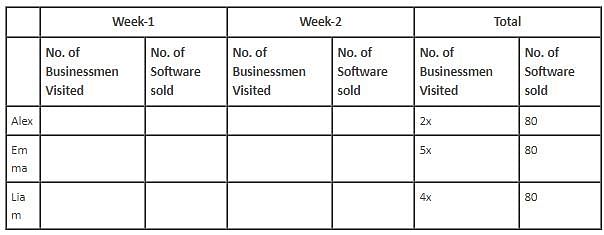
Liam visited the number of businessmen in week-1 and week-2 in the ratio 3 : 5 and sold software in the ratio 1 : 3.
Software sold by Liam in week-1 = × 80 = 20
× 80 = 20
Software sold by Liam in week-2 = × 80 = 60
× 80 = 60
Number of businessmen visited by Liam in week-1 = × 4x =
× 4x = 
Number of businessmen visited by Liam in week-2 = × 4x =
× 4x =
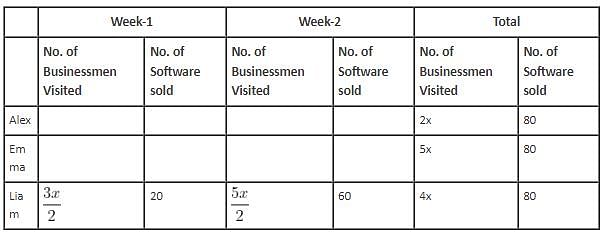
Emma sold 56 Software in week-2.
So, the number of software sold by Emma in week-1 = 80 – 56 = 24
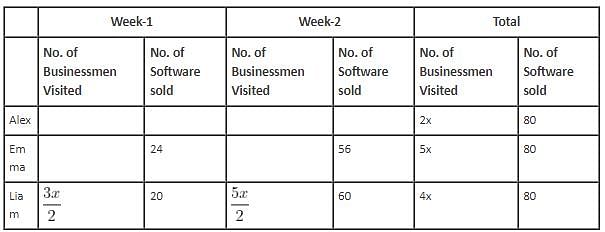
Alex visited 10 more businessmen in week-2 than week-1.
Let the number of businessmen visited by Alex in week-1 and week-2 be 'a' and 'b', respectively.
b – a = 10
b + a = 2x
On solving, we get
b = x + 5,
And a = x – 5

Success rate of Emma for week -1 is 2/3.
Let number of businessmen visited by Emma in week-1 = t
So,
t = 36
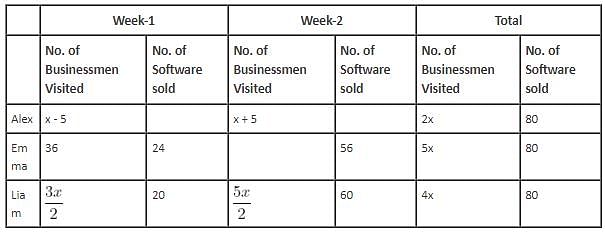
Altogether they visited 81 businessmen in week-1.
So,( x – 5) + 36 + = 81
= 81
On solving, we get
x = 20
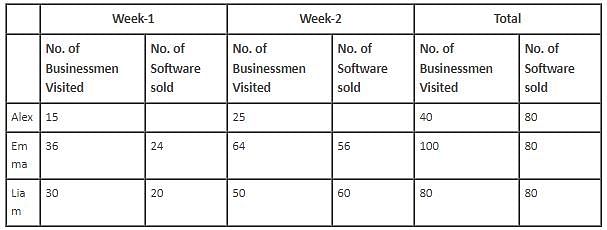
Success rate of Alex for week-1 is 7/3.
Let the number of software sold by Alex in week -1 is y.
So,
y = 35
Therefore, the final table will be:
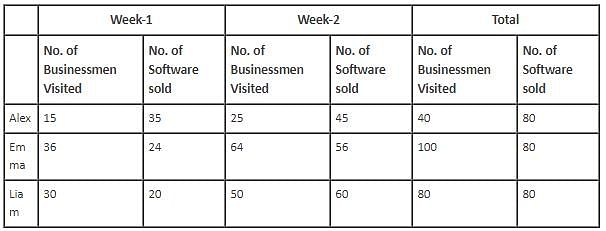
Let number of businessmen visited by Alex = 2x,
Number of businessmen visited by Emma = 5x,
Number of businessmen visited by Liam = 4x

Liam visited the number of businessmen in week-1 and week-2 in the ratio 3 : 5 and sold software in the ratio 1 : 3.
Software sold by Liam in week-1 =
 × 80 = 20
× 80 = 20Software sold by Liam in week-2 =
 × 80 = 60
× 80 = 60Number of businessmen visited by Liam in week-1 =
 × 4x =
× 4x = 
Number of businessmen visited by Liam in week-2 =
 × 4x =
× 4x =

Emma sold 56 Software in week-2.
So, the number of software sold by Emma in week-1 = 80 – 56 = 24

Alex visited 10 more businessmen in week-2 than week-1.
Let the number of businessmen visited by Alex in week-1 and week-2 be 'a' and 'b', respectively.
b – a = 10
b + a = 2x
On solving, we get
b = x + 5,
And a = x – 5

Success rate of Emma for week -1 is 2/3.
Let number of businessmen visited by Emma in week-1 = t
So,

t = 36

Altogether they visited 81 businessmen in week-1.
So,( x – 5) + 36 +
 = 81
= 81On solving, we get
x = 20

Success rate of Alex for week-1 is 7/3.
Let the number of software sold by Alex in week -1 is y.
So,

y = 35
Therefore, the final table will be:

Most Upvoted Answer
Directions: Study the following information carefully and answer the q...
Analysis:
Given information:
- Alex, Emma, and Liam sold 80 software each over two weeks.
- The number of businessmen visited by Alex, Emma, and Liam are in the ratio 2:5:4.
- Emma's success rate for week-1 is 2/3 and Alex's success rate for the same week is 7/3.
- All three visited 81 businessmen in week-1.
- Emma sold 56 software in week-2.
- Alex visited 10 more businessmen in week-2 than week-1.
- All the sales professionals visited more businessmen in week-2 compared to week-1.
- Liam visited businessmen in week-1 and week-2 in the ratio 3:5 and sold software in the ratio 1:3.
Solution:
1. Calculate the number of businessmen visited by each:
- Let the number of businessmen visited by Alex, Emma, and Liam be 2x, 5x, and 4x respectively.
- Total businessmen visited in week-1 = 2x + 5x + 4x = 11x = 81
- x = 81/11 = 7
2. Determine the number of software sold by each in week-1:
- Alex sold 80 software in two weeks, so in week-1, he sold 80 - 56 = 24 software.
- Emma sold 80 software in two weeks, so in week-1, she sold 56 software.
- Liam sold 80 software in two weeks, so in week-1, he sold 80 - 24 - 56 = 0 software.
3. Find the number of businessmen visited by Alex in week-2:
- Since Alex visited 10 more businessmen in week-2 than week-1, the number of businessmen visited by Alex in week-2 = 2(7) + 10 = 24
4. Calculate the number of software sold by Alex in week-2:
- Alex's success rate for week-1 is 7/3, so the number of software sold by Alex in week-1 = (7/3) * 24 = 56
- Total software sold by Alex in two weeks = 80, so the number of software sold by Alex in week-2 = 80 - 56 = 24
Therefore, Alex sold 24 software in week-2.
Given information:
- Alex, Emma, and Liam sold 80 software each over two weeks.
- The number of businessmen visited by Alex, Emma, and Liam are in the ratio 2:5:4.
- Emma's success rate for week-1 is 2/3 and Alex's success rate for the same week is 7/3.
- All three visited 81 businessmen in week-1.
- Emma sold 56 software in week-2.
- Alex visited 10 more businessmen in week-2 than week-1.
- All the sales professionals visited more businessmen in week-2 compared to week-1.
- Liam visited businessmen in week-1 and week-2 in the ratio 3:5 and sold software in the ratio 1:3.
Solution:
1. Calculate the number of businessmen visited by each:
- Let the number of businessmen visited by Alex, Emma, and Liam be 2x, 5x, and 4x respectively.
- Total businessmen visited in week-1 = 2x + 5x + 4x = 11x = 81
- x = 81/11 = 7
2. Determine the number of software sold by each in week-1:
- Alex sold 80 software in two weeks, so in week-1, he sold 80 - 56 = 24 software.
- Emma sold 80 software in two weeks, so in week-1, she sold 56 software.
- Liam sold 80 software in two weeks, so in week-1, he sold 80 - 24 - 56 = 0 software.
3. Find the number of businessmen visited by Alex in week-2:
- Since Alex visited 10 more businessmen in week-2 than week-1, the number of businessmen visited by Alex in week-2 = 2(7) + 10 = 24
4. Calculate the number of software sold by Alex in week-2:
- Alex's success rate for week-1 is 7/3, so the number of software sold by Alex in week-1 = (7/3) * 24 = 56
- Total software sold by Alex in two weeks = 80, so the number of software sold by Alex in week-2 = 80 - 56 = 24
Therefore, Alex sold 24 software in week-2.
Free Test
FREE
| Start Free Test |
Community Answer
Directions: Study the following information carefully and answer the q...
Over the course of two weeks, the number of businessmen visited by Alex, Emma and Liam are in the ratio 2 : 5 : 4, however each of them sold 80 software.
Let number of businessmen visited by Alex = 2x,
Number of businessmen visited by Emma = 5x,
Number of businessmen visited by Liam = 4x

Liam visited the number of businessmen in week-1 and week-2 in the ratio 3 : 5 and sold software in the ratio 1 : 3.
Software sold by Liam in week-1 = × 80 = 20
× 80 = 20
Software sold by Liam in week-2 = × 80 = 60
× 80 = 60
Number of businessmen visited by Liam in week-1 = × 4x =
× 4x = 
Number of businessmen visited by Liam in week-2 = × 4x =
× 4x =

Emma sold 56 Software in week-2.
So, the number of software sold by Emma in week-1 = 80 – 56 = 24

Alex visited 10 more businessmen in week-2 than week-1.
Let the number of businessmen visited by Alex in week-1 and week-2 be 'a' and 'b', respectively.
b – a = 10
b + a = 2x
On solving, we get
b = x + 5,
And a = x – 5

Success rate of Emma for week -1 is 2/3.
Let number of businessmen visited by Emma in week-1 = t
So,
t = 36

Altogether they visited 81 businessmen in week-1.
So,( x – 5) + 36 + = 81
= 81
On solving, we get
x = 20

Success rate of Alex for week-1 is 7/3.
Let the number of software sold by Alex in week -1 is y.
So,
y = 35
Therefore, the final table will be:

Let number of businessmen visited by Alex = 2x,
Number of businessmen visited by Emma = 5x,
Number of businessmen visited by Liam = 4x

Liam visited the number of businessmen in week-1 and week-2 in the ratio 3 : 5 and sold software in the ratio 1 : 3.
Software sold by Liam in week-1 =
 × 80 = 20
× 80 = 20Software sold by Liam in week-2 =
 × 80 = 60
× 80 = 60Number of businessmen visited by Liam in week-1 =
 × 4x =
× 4x = 
Number of businessmen visited by Liam in week-2 =
 × 4x =
× 4x =

Emma sold 56 Software in week-2.
So, the number of software sold by Emma in week-1 = 80 – 56 = 24

Alex visited 10 more businessmen in week-2 than week-1.
Let the number of businessmen visited by Alex in week-1 and week-2 be 'a' and 'b', respectively.
b – a = 10
b + a = 2x
On solving, we get
b = x + 5,
And a = x – 5

Success rate of Emma for week -1 is 2/3.
Let number of businessmen visited by Emma in week-1 = t
So,

t = 36

Altogether they visited 81 businessmen in week-1.
So,( x – 5) + 36 +
 = 81
= 81On solving, we get
x = 20

Success rate of Alex for week-1 is 7/3.
Let the number of software sold by Alex in week -1 is y.
So,

y = 35
Therefore, the final table will be:


|
Explore Courses for CAT exam
|

|
Similar CAT Doubts
Directions: Study the following information carefully and answer the question.In a bustling city known for its thriving tech industry, three talented sales professionals, Alex, Emma, and Liam, were entrusted with the task of promoting an innovative software solution called LinkPro to various businesses. Each week, they were assigned different territories to cover. Once a sales professional enters in a particular territory, he can meet any number of businessmen and any businessman can buy any number of software or may not buy any software. The success rate of a sales professional for a week is defined as the ratio of the number of software sold to the number of businessmen visited in that week. Some details about their performances are given below:(i) Over the course of two weeks, the number of businessmen visited by Alex, Emma and Liam are in the ratio 2 : 5 : 4, however each of them sold 80 software.(ii) Emmas success rate for week-1 is 2/3 but Alexs success rate for the same week is 7/3, however altogether, all the three visited 81 businessmen in week-1.(iii) Emma sold 56 software in week-2.(iv) Alex visited 10 more businessmen in week-2 than week-1. However all the sales professionals visited more number of businessmen in week-2 as compared to week-1.(v) Liam visited the number of businessmen in week-1 and week-2 in the ratio 3 : 5 and sold software in the ratio 1 : 3.Q.What is the number of software sold by Alex in week-2?Correct answer is '45'. Can you explain this answer?
Question Description
Directions: Study the following information carefully and answer the question.In a bustling city known for its thriving tech industry, three talented sales professionals, Alex, Emma, and Liam, were entrusted with the task of promoting an innovative software solution called LinkPro to various businesses. Each week, they were assigned different territories to cover. Once a sales professional enters in a particular territory, he can meet any number of businessmen and any businessman can buy any number of software or may not buy any software. The success rate of a sales professional for a week is defined as the ratio of the number of software sold to the number of businessmen visited in that week. Some details about their performances are given below:(i) Over the course of two weeks, the number of businessmen visited by Alex, Emma and Liam are in the ratio 2 : 5 : 4, however each of them sold 80 software.(ii) Emmas success rate for week-1 is 2/3 but Alexs success rate for the same week is 7/3, however altogether, all the three visited 81 businessmen in week-1.(iii) Emma sold 56 software in week-2.(iv) Alex visited 10 more businessmen in week-2 than week-1. However all the sales professionals visited more number of businessmen in week-2 as compared to week-1.(v) Liam visited the number of businessmen in week-1 and week-2 in the ratio 3 : 5 and sold software in the ratio 1 : 3.Q.What is the number of software sold by Alex in week-2?Correct answer is '45'. Can you explain this answer? for CAT 2025 is part of CAT preparation. The Question and answers have been prepared according to the CAT exam syllabus. Information about Directions: Study the following information carefully and answer the question.In a bustling city known for its thriving tech industry, three talented sales professionals, Alex, Emma, and Liam, were entrusted with the task of promoting an innovative software solution called LinkPro to various businesses. Each week, they were assigned different territories to cover. Once a sales professional enters in a particular territory, he can meet any number of businessmen and any businessman can buy any number of software or may not buy any software. The success rate of a sales professional for a week is defined as the ratio of the number of software sold to the number of businessmen visited in that week. Some details about their performances are given below:(i) Over the course of two weeks, the number of businessmen visited by Alex, Emma and Liam are in the ratio 2 : 5 : 4, however each of them sold 80 software.(ii) Emmas success rate for week-1 is 2/3 but Alexs success rate for the same week is 7/3, however altogether, all the three visited 81 businessmen in week-1.(iii) Emma sold 56 software in week-2.(iv) Alex visited 10 more businessmen in week-2 than week-1. However all the sales professionals visited more number of businessmen in week-2 as compared to week-1.(v) Liam visited the number of businessmen in week-1 and week-2 in the ratio 3 : 5 and sold software in the ratio 1 : 3.Q.What is the number of software sold by Alex in week-2?Correct answer is '45'. Can you explain this answer? covers all topics & solutions for CAT 2025 Exam. Find important definitions, questions, meanings, examples, exercises and tests below for Directions: Study the following information carefully and answer the question.In a bustling city known for its thriving tech industry, three talented sales professionals, Alex, Emma, and Liam, were entrusted with the task of promoting an innovative software solution called LinkPro to various businesses. Each week, they were assigned different territories to cover. Once a sales professional enters in a particular territory, he can meet any number of businessmen and any businessman can buy any number of software or may not buy any software. The success rate of a sales professional for a week is defined as the ratio of the number of software sold to the number of businessmen visited in that week. Some details about their performances are given below:(i) Over the course of two weeks, the number of businessmen visited by Alex, Emma and Liam are in the ratio 2 : 5 : 4, however each of them sold 80 software.(ii) Emmas success rate for week-1 is 2/3 but Alexs success rate for the same week is 7/3, however altogether, all the three visited 81 businessmen in week-1.(iii) Emma sold 56 software in week-2.(iv) Alex visited 10 more businessmen in week-2 than week-1. However all the sales professionals visited more number of businessmen in week-2 as compared to week-1.(v) Liam visited the number of businessmen in week-1 and week-2 in the ratio 3 : 5 and sold software in the ratio 1 : 3.Q.What is the number of software sold by Alex in week-2?Correct answer is '45'. Can you explain this answer?.
Directions: Study the following information carefully and answer the question.In a bustling city known for its thriving tech industry, three talented sales professionals, Alex, Emma, and Liam, were entrusted with the task of promoting an innovative software solution called LinkPro to various businesses. Each week, they were assigned different territories to cover. Once a sales professional enters in a particular territory, he can meet any number of businessmen and any businessman can buy any number of software or may not buy any software. The success rate of a sales professional for a week is defined as the ratio of the number of software sold to the number of businessmen visited in that week. Some details about their performances are given below:(i) Over the course of two weeks, the number of businessmen visited by Alex, Emma and Liam are in the ratio 2 : 5 : 4, however each of them sold 80 software.(ii) Emmas success rate for week-1 is 2/3 but Alexs success rate for the same week is 7/3, however altogether, all the three visited 81 businessmen in week-1.(iii) Emma sold 56 software in week-2.(iv) Alex visited 10 more businessmen in week-2 than week-1. However all the sales professionals visited more number of businessmen in week-2 as compared to week-1.(v) Liam visited the number of businessmen in week-1 and week-2 in the ratio 3 : 5 and sold software in the ratio 1 : 3.Q.What is the number of software sold by Alex in week-2?Correct answer is '45'. Can you explain this answer? for CAT 2025 is part of CAT preparation. The Question and answers have been prepared according to the CAT exam syllabus. Information about Directions: Study the following information carefully and answer the question.In a bustling city known for its thriving tech industry, three talented sales professionals, Alex, Emma, and Liam, were entrusted with the task of promoting an innovative software solution called LinkPro to various businesses. Each week, they were assigned different territories to cover. Once a sales professional enters in a particular territory, he can meet any number of businessmen and any businessman can buy any number of software or may not buy any software. The success rate of a sales professional for a week is defined as the ratio of the number of software sold to the number of businessmen visited in that week. Some details about their performances are given below:(i) Over the course of two weeks, the number of businessmen visited by Alex, Emma and Liam are in the ratio 2 : 5 : 4, however each of them sold 80 software.(ii) Emmas success rate for week-1 is 2/3 but Alexs success rate for the same week is 7/3, however altogether, all the three visited 81 businessmen in week-1.(iii) Emma sold 56 software in week-2.(iv) Alex visited 10 more businessmen in week-2 than week-1. However all the sales professionals visited more number of businessmen in week-2 as compared to week-1.(v) Liam visited the number of businessmen in week-1 and week-2 in the ratio 3 : 5 and sold software in the ratio 1 : 3.Q.What is the number of software sold by Alex in week-2?Correct answer is '45'. Can you explain this answer? covers all topics & solutions for CAT 2025 Exam. Find important definitions, questions, meanings, examples, exercises and tests below for Directions: Study the following information carefully and answer the question.In a bustling city known for its thriving tech industry, three talented sales professionals, Alex, Emma, and Liam, were entrusted with the task of promoting an innovative software solution called LinkPro to various businesses. Each week, they were assigned different territories to cover. Once a sales professional enters in a particular territory, he can meet any number of businessmen and any businessman can buy any number of software or may not buy any software. The success rate of a sales professional for a week is defined as the ratio of the number of software sold to the number of businessmen visited in that week. Some details about their performances are given below:(i) Over the course of two weeks, the number of businessmen visited by Alex, Emma and Liam are in the ratio 2 : 5 : 4, however each of them sold 80 software.(ii) Emmas success rate for week-1 is 2/3 but Alexs success rate for the same week is 7/3, however altogether, all the three visited 81 businessmen in week-1.(iii) Emma sold 56 software in week-2.(iv) Alex visited 10 more businessmen in week-2 than week-1. However all the sales professionals visited more number of businessmen in week-2 as compared to week-1.(v) Liam visited the number of businessmen in week-1 and week-2 in the ratio 3 : 5 and sold software in the ratio 1 : 3.Q.What is the number of software sold by Alex in week-2?Correct answer is '45'. Can you explain this answer?.
Solutions for Directions: Study the following information carefully and answer the question.In a bustling city known for its thriving tech industry, three talented sales professionals, Alex, Emma, and Liam, were entrusted with the task of promoting an innovative software solution called LinkPro to various businesses. Each week, they were assigned different territories to cover. Once a sales professional enters in a particular territory, he can meet any number of businessmen and any businessman can buy any number of software or may not buy any software. The success rate of a sales professional for a week is defined as the ratio of the number of software sold to the number of businessmen visited in that week. Some details about their performances are given below:(i) Over the course of two weeks, the number of businessmen visited by Alex, Emma and Liam are in the ratio 2 : 5 : 4, however each of them sold 80 software.(ii) Emmas success rate for week-1 is 2/3 but Alexs success rate for the same week is 7/3, however altogether, all the three visited 81 businessmen in week-1.(iii) Emma sold 56 software in week-2.(iv) Alex visited 10 more businessmen in week-2 than week-1. However all the sales professionals visited more number of businessmen in week-2 as compared to week-1.(v) Liam visited the number of businessmen in week-1 and week-2 in the ratio 3 : 5 and sold software in the ratio 1 : 3.Q.What is the number of software sold by Alex in week-2?Correct answer is '45'. Can you explain this answer? in English & in Hindi are available as part of our courses for CAT.
Download more important topics, notes, lectures and mock test series for CAT Exam by signing up for free.
Here you can find the meaning of Directions: Study the following information carefully and answer the question.In a bustling city known for its thriving tech industry, three talented sales professionals, Alex, Emma, and Liam, were entrusted with the task of promoting an innovative software solution called LinkPro to various businesses. Each week, they were assigned different territories to cover. Once a sales professional enters in a particular territory, he can meet any number of businessmen and any businessman can buy any number of software or may not buy any software. The success rate of a sales professional for a week is defined as the ratio of the number of software sold to the number of businessmen visited in that week. Some details about their performances are given below:(i) Over the course of two weeks, the number of businessmen visited by Alex, Emma and Liam are in the ratio 2 : 5 : 4, however each of them sold 80 software.(ii) Emmas success rate for week-1 is 2/3 but Alexs success rate for the same week is 7/3, however altogether, all the three visited 81 businessmen in week-1.(iii) Emma sold 56 software in week-2.(iv) Alex visited 10 more businessmen in week-2 than week-1. However all the sales professionals visited more number of businessmen in week-2 as compared to week-1.(v) Liam visited the number of businessmen in week-1 and week-2 in the ratio 3 : 5 and sold software in the ratio 1 : 3.Q.What is the number of software sold by Alex in week-2?Correct answer is '45'. Can you explain this answer? defined & explained in the simplest way possible. Besides giving the explanation of
Directions: Study the following information carefully and answer the question.In a bustling city known for its thriving tech industry, three talented sales professionals, Alex, Emma, and Liam, were entrusted with the task of promoting an innovative software solution called LinkPro to various businesses. Each week, they were assigned different territories to cover. Once a sales professional enters in a particular territory, he can meet any number of businessmen and any businessman can buy any number of software or may not buy any software. The success rate of a sales professional for a week is defined as the ratio of the number of software sold to the number of businessmen visited in that week. Some details about their performances are given below:(i) Over the course of two weeks, the number of businessmen visited by Alex, Emma and Liam are in the ratio 2 : 5 : 4, however each of them sold 80 software.(ii) Emmas success rate for week-1 is 2/3 but Alexs success rate for the same week is 7/3, however altogether, all the three visited 81 businessmen in week-1.(iii) Emma sold 56 software in week-2.(iv) Alex visited 10 more businessmen in week-2 than week-1. However all the sales professionals visited more number of businessmen in week-2 as compared to week-1.(v) Liam visited the number of businessmen in week-1 and week-2 in the ratio 3 : 5 and sold software in the ratio 1 : 3.Q.What is the number of software sold by Alex in week-2?Correct answer is '45'. Can you explain this answer?, a detailed solution for Directions: Study the following information carefully and answer the question.In a bustling city known for its thriving tech industry, three talented sales professionals, Alex, Emma, and Liam, were entrusted with the task of promoting an innovative software solution called LinkPro to various businesses. Each week, they were assigned different territories to cover. Once a sales professional enters in a particular territory, he can meet any number of businessmen and any businessman can buy any number of software or may not buy any software. The success rate of a sales professional for a week is defined as the ratio of the number of software sold to the number of businessmen visited in that week. Some details about their performances are given below:(i) Over the course of two weeks, the number of businessmen visited by Alex, Emma and Liam are in the ratio 2 : 5 : 4, however each of them sold 80 software.(ii) Emmas success rate for week-1 is 2/3 but Alexs success rate for the same week is 7/3, however altogether, all the three visited 81 businessmen in week-1.(iii) Emma sold 56 software in week-2.(iv) Alex visited 10 more businessmen in week-2 than week-1. However all the sales professionals visited more number of businessmen in week-2 as compared to week-1.(v) Liam visited the number of businessmen in week-1 and week-2 in the ratio 3 : 5 and sold software in the ratio 1 : 3.Q.What is the number of software sold by Alex in week-2?Correct answer is '45'. Can you explain this answer? has been provided alongside types of Directions: Study the following information carefully and answer the question.In a bustling city known for its thriving tech industry, three talented sales professionals, Alex, Emma, and Liam, were entrusted with the task of promoting an innovative software solution called LinkPro to various businesses. Each week, they were assigned different territories to cover. Once a sales professional enters in a particular territory, he can meet any number of businessmen and any businessman can buy any number of software or may not buy any software. The success rate of a sales professional for a week is defined as the ratio of the number of software sold to the number of businessmen visited in that week. Some details about their performances are given below:(i) Over the course of two weeks, the number of businessmen visited by Alex, Emma and Liam are in the ratio 2 : 5 : 4, however each of them sold 80 software.(ii) Emmas success rate for week-1 is 2/3 but Alexs success rate for the same week is 7/3, however altogether, all the three visited 81 businessmen in week-1.(iii) Emma sold 56 software in week-2.(iv) Alex visited 10 more businessmen in week-2 than week-1. However all the sales professionals visited more number of businessmen in week-2 as compared to week-1.(v) Liam visited the number of businessmen in week-1 and week-2 in the ratio 3 : 5 and sold software in the ratio 1 : 3.Q.What is the number of software sold by Alex in week-2?Correct answer is '45'. Can you explain this answer? theory, EduRev gives you an
ample number of questions to practice Directions: Study the following information carefully and answer the question.In a bustling city known for its thriving tech industry, three talented sales professionals, Alex, Emma, and Liam, were entrusted with the task of promoting an innovative software solution called LinkPro to various businesses. Each week, they were assigned different territories to cover. Once a sales professional enters in a particular territory, he can meet any number of businessmen and any businessman can buy any number of software or may not buy any software. The success rate of a sales professional for a week is defined as the ratio of the number of software sold to the number of businessmen visited in that week. Some details about their performances are given below:(i) Over the course of two weeks, the number of businessmen visited by Alex, Emma and Liam are in the ratio 2 : 5 : 4, however each of them sold 80 software.(ii) Emmas success rate for week-1 is 2/3 but Alexs success rate for the same week is 7/3, however altogether, all the three visited 81 businessmen in week-1.(iii) Emma sold 56 software in week-2.(iv) Alex visited 10 more businessmen in week-2 than week-1. However all the sales professionals visited more number of businessmen in week-2 as compared to week-1.(v) Liam visited the number of businessmen in week-1 and week-2 in the ratio 3 : 5 and sold software in the ratio 1 : 3.Q.What is the number of software sold by Alex in week-2?Correct answer is '45'. Can you explain this answer? tests, examples and also practice CAT tests.

|
Explore Courses for CAT exam
|

|
Signup for Free!
Signup to see your scores go up within 7 days! Learn & Practice with 1000+ FREE Notes, Videos & Tests.


























